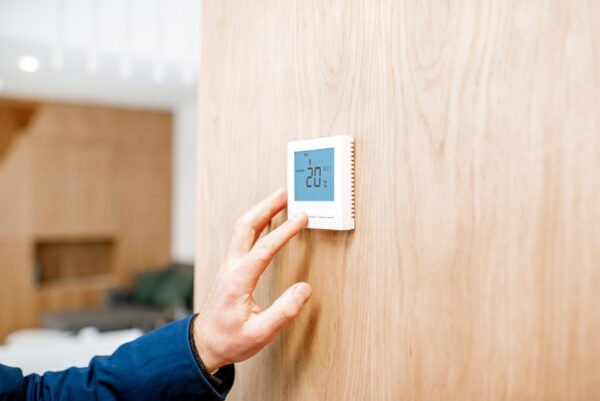September 22, 2023

8 Steps To Winterproof Your Heating System
As the days grow shorter and the temperature starts to drop, it’s essential to ensure that your heating system is ready to keep you warm and comfortable throughout the winter months. Winterizing your heating system not only helps maintain its efficiency but also prevents potential breakdowns during the coldest time of the year. In this blog post, we’ll discuss the essential steps you can take to prepare your heating system for the winter season.
1. Schedule a Professional Inspection
Before the winter chill sets in, it’s a smart move to schedule a professional inspection for your heating system. A certified HVAC technician can identify any existing issues and recommend necessary repairs. Regular maintenance can extend the lifespan of your system and prevent unexpected breakdowns when you need heat the most. During the inspection, the technician will likely check for leaks, clean or replace air filters, and ensure that all components are functioning optimally.
2. Clean and Replace Air Filters
Air filters play a crucial role in maintaining indoor air quality and the efficiency of your heating system. Dirty and clogged filters can restrict airflow, causing your system to work harder and consume more energy. Regularly cleaning or replacing air filters, ideally every one to three months, can ensure proper airflow, improve indoor air quality, and help your heating system operate efficiently throughout the winter.
3. Check and Seal Ductwork
Leaky ductwork can lead to a significant loss of heated air, reducing the efficiency of your heating system. Check your ductwork for any visible gaps, cracks, or disconnected sections. Seal these areas using HVAC-approved duct tape or mastic sealant. Properly sealed ducts can prevent heat loss and save you money on energy bills.
4. Insulate Your Home
Proper insulation plays a vital role in keeping the heat generated by your heating system inside your home. Check your home’s insulation, especially in areas like the attic, walls, and basement. Adding or improving insulation can help your heating system work more efficiently by reducing heat loss. Additionally, consider using draft stoppers or weatherstripping around doors and windows to prevent cold air from entering your home.
5. Programmable Thermostats
Investing in a programmable thermostat can make a significant difference in your heating system’s efficiency. These thermostats allow you to set different temperatures for different times of the day, ensuring that you’re not heating your home excessively when you don’t need to. Lowering the temperature while you’re away or sleeping can lead to substantial energy savings over the winter months.
6. Bleed Radiators
If you have a radiator-based heating system, it’s important to bleed your radiators before the winter season begins. Air can accumulate within the radiator, preventing it from heating efficiently. To do this, turn off the heating system, wait for the radiators to cool down, and then use a radiator key to open the air vent. You should hear a hissing noise as air passes through the vent and out. Once water starts to trickle out, close the vent. This simple step ensures that your radiators can distribute heat effectively.
7. Clear Heating Vents and Registers
Make sure that heating vents and registers are clear of obstructions such as furniture, rugs, or drapes. Blocked vents can restrict airflow and hinder the proper distribution of warm air throughout your home. Keeping these areas unobstructed allows your heating system to work efficiently and maintain a comfortable indoor temperature.
8. Test Your Heating System
Before the temperature drops significantly, test your heating system to ensure that it’s working as expected. Turn on the system and set the thermostat to a higher temperature to see if warm air is being produced and distributed evenly. This test can help you identify any issues that might need professional attention before you actually need the heat.
Emergency Preparedness and Maintenance Tips
While proactive winterization steps are essential to ensure your heating system’s optimal performance, it’s also crucial to be prepared for unexpected situations. Extreme winter weather can sometimes lead to power outages or heating system malfunctions. Here are some emergency preparedness and maintenance tips to keep in mind.
1. Stock Up on Emergency Supplies
In case of a power outage or heating system failure during a winter storm, it’s wise to have a stock of emergency supplies on hand. Items such as extra blankets, warm clothing, portable heaters (electric or propane-powered), and non-perishable food can make a significant difference in keeping you and your family comfortable until the heating system is operational again.
2. Regularly Check Carbon Monoxide Detectors
Carbon monoxide (CO) is a colorless and odorless gas that can be produced by malfunctioning heating systems. Ensure that you have working carbon monoxide detectors installed throughout your home, especially in areas near bedrooms. Test these detectors regularly and replace their batteries as needed. If a detector ever goes off or you suspect a CO leak, evacuate your home immediately and contact emergency services.
3. Learn Basic Maintenance Tasks
While some heating system issues might require professional assistance, learning basic maintenance tasks can be incredibly useful during emergencies. Familiarize yourself with tasks like resetting the system, checking the circuit breaker, and restarting the pilot light (if applicable). Keep the manufacturer’s manual handy for reference.
4. Establish a Maintenance Schedule
Beyond the initial winterization steps, establish a maintenance schedule for your heating system throughout the winter season. Regularly check for any unusual sounds, odors, or changes in performance. If you notice anything unusual, address it promptly to prevent a minor issue from escalating into a major problem.
5. Have a Professional’s Contact Information
Even with the best preparation, unexpected issues can arise. Make sure you have the contact information of a reputable HVAC professional who provides emergency services. Having a trusted technician’s number on hand can save valuable time and help you resolve heating system problems quickly.
6. Snow and Ice Removal Around Outdoor Units
If you have an outdoor HVAC unit, heavy snow or ice accumulation can impact its efficiency. Gently remove snow and ice from the unit, being careful not to damage any components. However, exercise caution and prioritize safety; if the unit is encased in ice or difficult to access, it’s best to wait for professional assistance.
7. Consider a Generator
Investing in a backup generator can provide peace of mind during severe winter weather. A generator can power essential appliances and your heating system in case of a power outage. Consult with an electrician to determine the appropriate size and type of generator for your needs.
Winterize Your HVAC System With the Help of a Pro!
Winterizing your heating system is a proactive approach that can save you money, prevent breakdowns, and keep your home comfortable during the colder months. By following these steps – scheduling a professional inspection, maintaining air filters, checking and sealing ductwork, insulating your home, using programmable thermostats, bleeding radiators, clearing heating vents, and testing your system – you can ensure that your heating system operates efficiently and effectively throughout the winter season. Taking these measures will not only keep you warm but also contribute to a more energy-efficient and eco-friendly household. Contact Scott-Lee Heating Company today to schedule an inspection and maintenance for your heating system!
